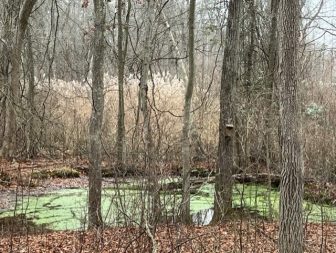Members of the New Canaan High School Science Team identified unusually high levels of phosphorus in Bristow Bird Sanctuary based on samples collected this past summer, according to a presentation the students gave last week.

Bristow Bird Sanctuary on Dec. 11, 2022. Credit: Michael Dinan
Natural levels of the chemical element should come in around .1 mg/L for streams with no reservoirs, yet tests conducted by a lab in June following a sample at Bristow came back at more than six times that amount, according to Andrew Yuang, a NCHS student who joined Science Team Co-Captain Kira Titova at the Dec. 8 Conservation Commission meeting, held in Town Hall and via videoconference.
Asked by Commission Chair what negative impact of high phosphorus could be, Yuang said that, similarly to nitrogen, high phosphorus that comes into a waterway—typically, from fertilizer—could lead to an overgrowth in algae which, in turn, reduces the amount of dissolved oxygen that aquatic life needs to breathe, an environmental condition called hypoxia.

Bristow Bird Sanctuary on Dec. 11, 2022. Credit: Michael Dinan
Schipper said, “It makes sense we are doing this test, because we are concerned about what is happening in our freshwater streams and ponds, but we’re also concerned about the downstream effect on Long Island Sound, and I would say i’m not surprised that there might be a very high reading because, as a regular visitor to Bristow and Bristow Pond, I’ve noticed the pond is often so heavy with plant life it feels like a snapping turtle could walk across the top of it, as opposed to swim underneath it. And so we actually have that kind of Petri dish of plant growth that you can see going up high and then fall off—it helps that the stream continually flushes water through there. On the other hand, in a drought period with a lot of sunlight you’re going to see this bloom of plants and I suppose that could limit the number of frogs that could live in the water, or anything else.”
The discussion came during a presentation led by Titova, leader of the team’s water testing project.

Bristow Bird Sanctuary on Dec. 11, 2022. Credit: Michael Dinan
It’s a continuation from last year, with a goal of studying “the different nutrients in the water in Mead Pond and the Noroton rivershed because this affects the local wildlife,” Titova said. The team had six sampling days—three dry-weather and three wet-weather—from June to October, studying not only phosphorus but dissolved oxygen, nitrogen, nitrate and ammonia nitrate. They sampled seven sites, including one on private property (Indian Waters Drive). Nikki Spiller from Harbor Watch is coordinator of the project—and gave an overview of water testing throughout New Canaan during the meeting—and Reka Cebulski is NCHS faculty advisor to the team, and sample testing was done by York Analytical Laboratories Inc., Titova said.

Barred owl photographed Monday, Oct. 9, 2020 in Bristow Bird Sanctuary. Photo courtesy of Chris Schipper
Spiller said that because the phosphorus results from a June 8 test were “glaringly high,” she reached out to York, but the lab was unable to confirm whether it was a transcription error, so the team is taking it at face value.
Schipper said, “One possible observation, and this is just speculative, but it is possible they treated the fields with fertilizer in that cycle, the June cycle.”
He referred to baseball fields at Mead Park, which adjoins Bristow.
The Science Team’s testing did not raise any other major red flags. For example, according to Titova, the Connecticut standard for dissolved oxygen is 5mg/L “and most of our sites were above that.”
“But a healthy level is really about 6.5 to 8 mg/L because this is when it’s enough for all the different kinds of aquatic life but not too much that it’s causing overgrowth, and this year our average was 6.947 mg/L which was a slight increase from last year’s 6.889 mg/L so it’s trending upwards which is good,” though two sites located near the baseball fields had higher values, she said.

Friends of Bristow Park and Wildlife in Crisis on May 5, 2020 released two orphaned and rehabilitated bluebirds at the park. Photo courtesy of Chris Schipper
The dissolved oxygen “is used for fish and other aquatic life that need it to breathe,” Titova said.
“And it comes from algae and other aquatic plants that create oxygen when they go through photosynthesis and then when there is decomposition in the water, the decomposers also use that oxygen in order to survive,” she said. “So In the summer months, we usually are usually supposed to see higher levels of dissolved oxygen because the warm water holds the dissolved oxygen better.”
The commissioners asked why there were lower levels of dissolved oxygen in the sites near the fields versus the inlets and outlets of the area (it could be due to sediment buildup), whether there were differences in the readings on rainy versus dry days (yes), what is the source of nitrate in the water (fertilizer runoff), whether the Science Team would recommend continuing the testing at a site by a grate on Old Stamford Road (yes), what is the effect of the high levels on birds (it’s negative for them if they are prevented by overgrown algae from drinking the water or if it kills off plants and fish they need as resources) and what it means to see differences this year in results for nitrates on wet versus dry days (unclear, more sampling is needed to identify trends).

At the Bristow Bird Sanctuary and Wildwood Preserve. Photo courtesy of Phil Ives
Schipper asked whether at the level of dissolved oxygen found, Bristow park-goers could expect to see aquatic life in its streams and ponds.
Titova said, “Yes, and we definitely saw that there were plants on the surface of water and we saw a couple of fish in the water, especially in sites 1 and 2 which are near the big pond.”
The Commission asked Titova and Yuang what their future studies in college could include and they both said they’re interested in biological science. Commissioners thanked them for their work.
“Having these tests and results is a valuable exercise for us and gives us a constant tool to come back to,” Schipper said.


This is valuable information to have. The Sanctuary is linked to its surroundings, as are all properties in our town. Caring for our ecosystem involves more than maintaining appearances. Thanks to the New Canaan High School Science Team.
Thank you to the NCHS Science Team for raising awareness on this issue.
The same is happening at the nature center.
The pond in the far corner is completely covered with algae. It looks like a green field that one could walk on.